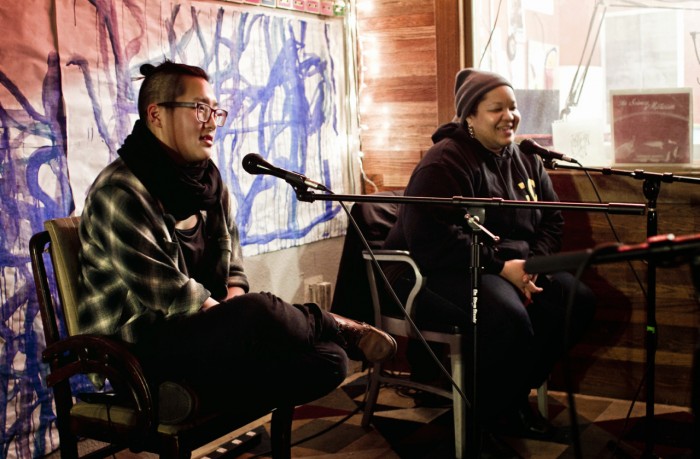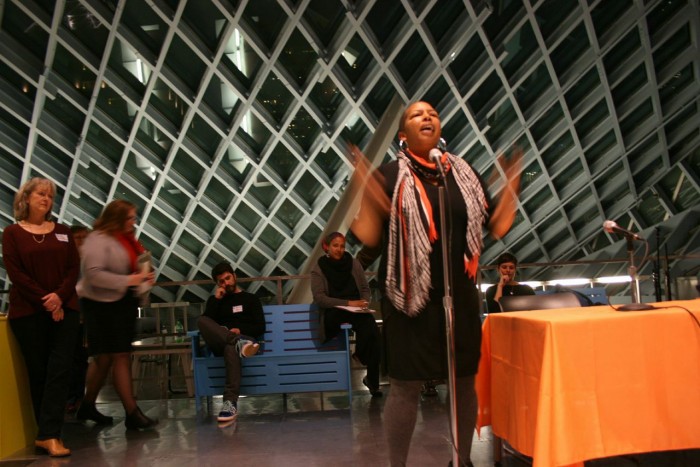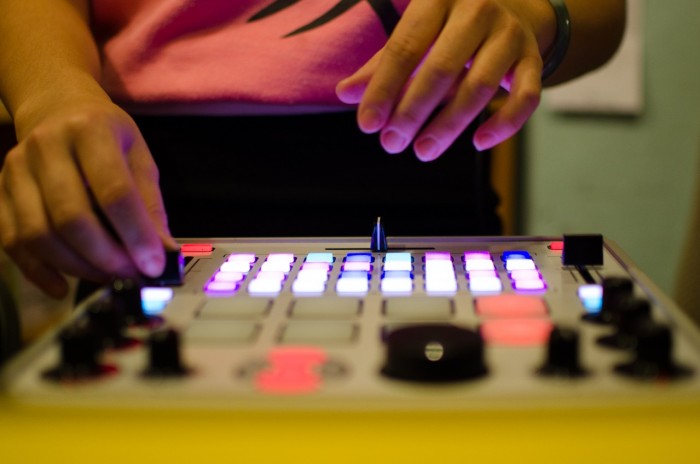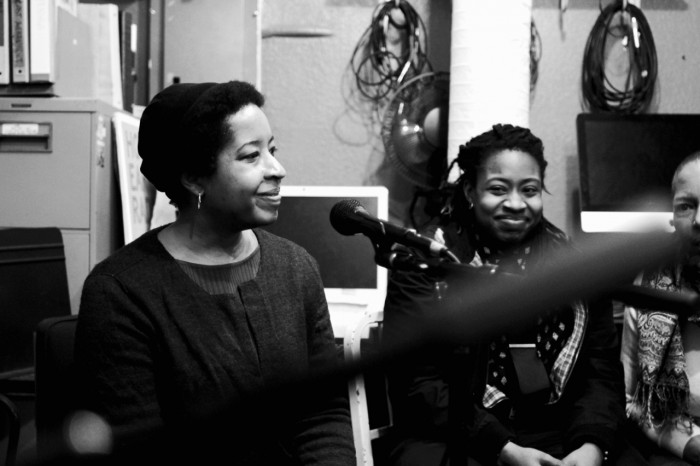
Last Friday on World Radio Day, about 100 people gathered at the Seattle Public Library downtown to celebrate the roll out of 13 new low-power FM radio stations (LPFM, for short), that will be squeezing onto the airwaves over the next year.
On the amount of power needed to light a single light bulb, these tiny community radio stations will broadcast to their immediate surroundings, right up against the corporate and public goliaths already dominating the FM dial.
So why is one of the most tech-forward cities in the nation celebrating such a low-tech revolution?
Because innovation, while sexy, doesn’t always translate to media justice. In Seattle, gentrification and development can make it feel like there’s a grassroots movement, affordable sandwich place, or queer dance party being squelched on every corner. Pretty soon, that may be true everywhere — except on the radio.
Of course, the folks at the Federal Communications Commission don’t necessarily like to talk in terms of ‘media justice.’ Though they helped put together the Local Community Radio Act, signed by Obama in 2011 to open up space on the airwaves for community organizations, they are hardly the ilk who started DIY radio shows in their basements and living rooms, throwing around terms like “terrestrial” (on the air, for newbies) and “barnraising” in affiliation with their craft.
And as development and growth displace communities of color from their historical homes in Seattle, the radio might just be the best bridge to reconnect them.
“People can learn about each other, because the media is not talking about us,” said Luzviminda Uzuri “Lulu” Carpenter, an organizer and radio host with Hollow Earth Radio, which currently braodcasts online but will be adding a terrestrial LPFM station soon.
“When I think about the possibility of somebody in Palestine or the Phillipines or Cuba listening to ourselves or our stories, you believe that you’re not alone,” she told the audience at the library last Friday.

Groups across the country filled out nearly 3,000 LPFM applications to the FCC, which granted licenses based on a point system that had little to do with actual programming and everything to do with guaranteeing localism, according to Sabrina Roach of Brown Paper Tickets (who is also a member of the Seattle Globalist board).
As the organizer behind the Puget Sound cohort of LFPM applicants, Roach was careful to foster the community building in the process, rather than set groups up for a “snake-pit” of competition, as she says happened in the Bay Area.
Roach did this by bringing applicant groups, ranging from greenhorn college radio stations to immigrant and refugee non-profits, together to learn about one another and find common goals for their stations and constituents.
In the end, all but two groups were awarded licenses, many hoping to engage the voices most marginalized in mainstream media — people of color, immigrants, working class people, and others without access to the expensive tools of the trade.
Though the stations are low-tech (about 90,000 watts less than KUOW, for example), startup costs for an LPFM station are estimated at about $16,000 and though many working on getting stations off the ground find the actual costs to be much higher.
Roach and her team have been helping applicants along the way find funding, but that hasn’t stopped people from doing it the old fashioned way — indiegogo campaigns and tip jars at the local co-op in Bellingham raised money for Make.Shift, one of the stations awarded a license this past fall. They are now in the planning phase for programming for their station, asking community members to offer ideas of what they’d like to see on the air.

In the wake of a podcasting media landscape that’s still recovering from a collective Serial hangover, it’s easy to fuss over just how cool LPFM promises to be. After all, it’s hyper, hyper local — stations have a 3.5 mile broadcast radius from their antennas, and just about anything goes, from Star Wars conversations to bedtime stories.
But the LPFM representatives last Friday from 13 different community groups from Tukwila to Duvall made one thing clear: this isn’t anything new, or trite. Above all, it’s leveraging airspace and partnerships to do what communities do best when left to their own devices: organize.
“Everyone wants to be a DJ. Not everyone wants to put a shoulder into the work of organizational development,” said Roach, who, following the convoluted process she led of applying for licenses, will step back to watch communities take the lead designing programming.
That’s what many of the groups present last Friday say they hope to do when their station goes live, sometime within the next year. Pavan Vangipuram, the Communications Manager at One America, the largest immigrant and refugee organization in the northwest, says using radio as a medium for their organizing work was unprecedented.
“It’s definitely a new venture for us,” he says, adding that he hopes the station will be shaped by the Latino and Somali immigrant communities they serve — offering news from home and abroad in their own languages, or things like community-led readings from religious texts, on air.
Some stations, like Hollow Earth Radio, have shows already up and running that will be transferred onto their own dial, 100.3 KGUT.
Carpenter began a show last year called #LuluNation + #SadBoisHypeClub, geared towards queer people of color talking on rotating topics that are important to the group but mostly invisible to mainstream media. Shows have included topics like ‘Complicated Joy’ and ‘Magical Vagueness,’ covered issues like police brutality and racism, and featured DJ’s spinning live music to on-air horoscope broadcasts.

The group crams into the studio every Tuesday evening, sinking into couches and passing around snacks, resembling more of a living-room chill session than a radio show. And just like in the living room, the talk runs deep. Guests got choked up last week discussing “Love in the Diaspora,” giving shout outs to family members and friends across the globe.
Another group, Rainier Valley Radio, will operate under an LPFM license stewarded by Southeast Effective Development (SEED). Tony Benton, a member of the Advisory Council, who spoke about the station at last Friday’s event, pointed out the urgency of community radio in his neighborhood, where demographics represented the opposite of the mostly-white room. Tony and Rainier Valley Radio organized to get city funding for a youth media training, which they secured and prepared for before ever going on the air.
How about offering radio programming and training for the 40 ethnicities and 60 languages of Rainier Valley?
“We look forward to this challenge,” Benton said. “We think that if we can accomplish this, this is a microcosm of the world, today”.
For many, community media like LPFM is an entry point into a field that’s currently dominated by white faces (and voices).
“My own parents and my own community hovered over radios to get whatever news they could get about what was happening back home” said Rahwa Habte, an organizer with Mayor Ed Murray’s office who has been helping immigrant communities around LPFM.
I recall my own work with an Inuit community in Nunavik, in remote northern Quebec, where I was surprised to see people tuning in to radio over facebook and the newspaper. More than just as a source of global and national news, young and old used it to keep up on the daily going-ons of a tiny town, especially when unthinkable winters kept people inside.

In Seattle, it’s less the winter that’s keeping us apart these days, and more ongoing displacement that’s come along with reshaping our city. For organizers who have been at it for some time, getting an LPFM station won’t change much, it will just be another tool.
James Keum, aka #auntieboi on #LuluNation + #SadBoisHypeClub, looks at LPFM as a new way to spin what communities have been doing globally in radio for some time. Indeed, Roach traced the origins of community radio to Zane Ibrahim, who used Bush Radio in South Africa as a tool to fight against apartheid. (Upon mentioning his name at the library, only a few in the room nodded in appreciation).
LPFM certainly won’t change the reality of displacement, poverty, and gentrification overnight. On Tuesday after her show, Carpenter stepped out onto the street on the corner of 20th and Union, for a breathe of fresh air. When she returned, she shook her head.
“There are no brown people on the street anymore,” she said. “It’s scary”.
As the streets of Seattle become more and more difficult places for longstanding communities to thrive, and the internet turns us inward with its vast technology, there’s a rare opportunity to leverage the power of community radio.
New LPFM stations might get us out of our cars, listening to podcasts in absentia, and put our focus back toward the people on our own streets.
This post has been updated since its original publication.


I'm 75 yrs old, a retired teacher and a music composer. I have found a new home. with WEQY 104.7FM Radio, The voice of the East Side. That's the east side of St. Paul, MN>
Keep pluggin' out there. We may be a bit behind, but we'll catch up!
if Hebrew-Americans stay i the neighborhood where they were born – they get accused of “maintaining de facto segregation”.
If Hebrew-American LEAVE, they get accused of “white flight”
If Hebrew-Americans RETURN to their neighborhood of birth – they get accused of “gentrification”
We already see the outlines of the future: the topnotch Hebrew-Americans will make aliyah.
Folks like Anna Goren are welcome to turn Seattle into Nueva Karachi. We will not be there.
Hollow Earth Radio’s IndieGoGo Campaign started today to gather funds to become a LPFM station to pay for our various equipment, insurance, engineering studies, and etc. Please consider donating! http://igg.me/at/khuh Thank you!